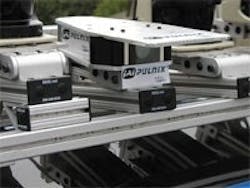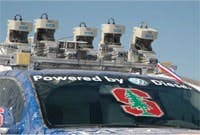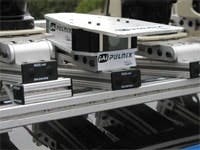Vision system guides racing team to victory
The DARPA (Defense Advanced Project Research Agency) 2005 Grand Challenge is the second such Challenge issued. The first Grand Challenge, (DARPA 2004) did not award a winner. For 2005, DARPA doubled the prize from $1M to $2M, and increased the length and difficulty of the course. The result for 2005 was that only five of 23 entries finished the course, and only four of those who finished did so within the 10-hour deadline. DARPA increased the difficulty of the challenge further by not revealing the course until the morning of the day of the race, when CDs containing the route information were distributed. The vehicles were thus required to navigate entirely without human intervention or guidance. The course included a variety of terrain, including dirt paths, winding mountain roads, choke points, and both man-made and natural obstacles.
During the year before the race, JAI PULNiX worked closely with Stanford, donating time and equipment and helping the team select the proper camera solution for their application. The PULNiX camera’s combination of 24-bit color, progressive scan, and a 60 Hz frame rate provided the team the video data to guide the vehicle in real time. The camera’s wide dynamic range, color definition, and high-speed shutter provided input to the system so it could make the best possible decisions as to what terrain was navigable. In addition, the camera needed to be rugged and resistant to the shock, vibration, heat, and direct sunlight it would encounter in the desert. The Cam2Net adapter was utilized because it reduced system complexity and easily converted the high-performance digital video into Gigabit Ethernet which could be ported into the Intel Blade servers for processing.
While some of the other teams used redundant systems and complex equipment to guide their vehicles, the Stanford approach was to rely on their software expertise and on off-the-shelf components to provide the most straightforward solution. Therefore, they designed a three-part software solution to get Stanley through. GPS provided an overall position, LADAR provided near-field profiling of obstacles, and the video from the PULNiX camera gave Stanley the data it needed to shift into high gear and drive beyond. Said Hendrick Dahlkamp, of the Stanford Racing Team: ‘‘The PULNiX camera gave Stanley the speed. Without it, we never would have won the race.’‘



